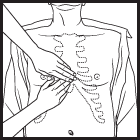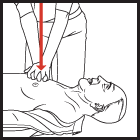CPR (Cardiopulmonary Resuscitation)
Page 1 of 1
 CPR (Cardiopulmonary Resuscitation)
CPR (Cardiopulmonary Resuscitation)
CPR IN THREE SIMPLE STEPS
http://depts.washington.edu/learncpr/quickcpr.html
3 Steps shown in easy to follow format ... go to link above for full instructions ...




VIDEO: http://depts.washington.edu/learncpr/videodemo/adult-cpr-video.html
http://depts.washington.edu/learncpr/quickcpr.html
3 Steps shown in easy to follow format ... go to link above for full instructions ...




VIDEO: http://depts.washington.edu/learncpr/videodemo/adult-cpr-video.html
_________________
Anything I post may NOT be used for commercial purposes or any type of 'For-Profit' distribution.


ReadyMom- Admin
- Posts : 7346
Join date : 2018-08-11
 Re: CPR (Cardiopulmonary Resuscitation)
Re: CPR (Cardiopulmonary Resuscitation)
Cardiopulmonary resuscitation (CPR): First aid
http://www.mayoclinic.com/health/first-aid-cpr/fa00061
By Mayo Clinic Staff
Cardiopulmonary resuscitation (CPR) is a lifesaving technique useful in many emergencies, including heart attack or near drowning, in which someone's breathing or heartbeat has stopped. Ideally, CPR involves two elements: chest compressions combined with mouth-to-mouth rescue breathing.
However, what you as a bystander should do in an emergency situation really depends on your knowledge and comfort level.
The bottom line is that it's far better to do something than to do nothing at all if you're fearful that your knowledge or abilities aren't 100 percent complete. Remember, the difference between your doing something and doing nothing could be someone's life.
Here's advice from the American Heart Association: ---CONTINUED---
http://www.mayoclinic.com/health/first-aid-cpr/fa00061
By Mayo Clinic Staff
Cardiopulmonary resuscitation (CPR) is a lifesaving technique useful in many emergencies, including heart attack or near drowning, in which someone's breathing or heartbeat has stopped. Ideally, CPR involves two elements: chest compressions combined with mouth-to-mouth rescue breathing.
However, what you as a bystander should do in an emergency situation really depends on your knowledge and comfort level.
The bottom line is that it's far better to do something than to do nothing at all if you're fearful that your knowledge or abilities aren't 100 percent complete. Remember, the difference between your doing something and doing nothing could be someone's life.
Here's advice from the American Heart Association: ---CONTINUED---
_________________
Anything I post may NOT be used for commercial purposes or any type of 'For-Profit' distribution.


ReadyMom- Admin
- Posts : 7346
Join date : 2018-08-11
 Re: CPR (Cardiopulmonary Resuscitation)
Re: CPR (Cardiopulmonary Resuscitation)
VIDEO: First Aid & CPR Basics : CPR Rescue Breaths
Learn how to give CPR rescue breaths in this free video clip on basic first aid and CPR.
Video at link, above
Learn how to give CPR rescue breaths in this free video clip on basic first aid and CPR.
Video at link, above
_________________
Anything I post may NOT be used for commercial purposes or any type of 'For-Profit' distribution.


ReadyMom- Admin
- Posts : 7346
Join date : 2018-08-11
Page 1 of 1
Permissions in this forum:
You cannot reply to topics in this forum

